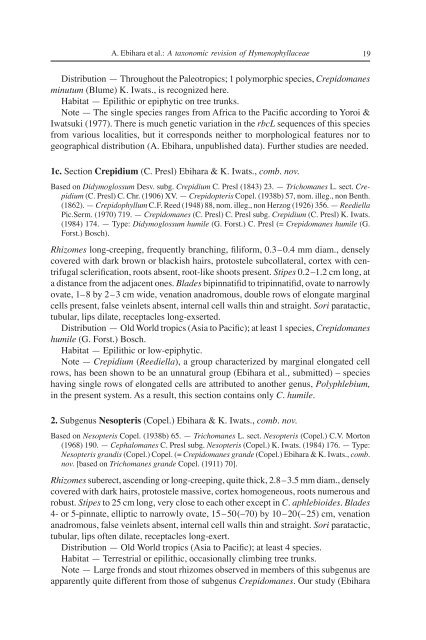A TAXONOMIC REVISION OF HYMENOPHYLLACEAE
A TAXONOMIC REVISION OF HYMENOPHYLLACEAE
A TAXONOMIC REVISION OF HYMENOPHYLLACEAE
Create successful ePaper yourself
Turn your PDF publications into a flip-book with our unique Google optimized e-Paper software.
A. Ebihara et al.: A taxonomic revision of Hymenophyllaceae<br />
Distribution — Throughout the Paleotropics; 1 polymorphic species, Crepidomanes<br />
minutum (Blume) K. Iwats., is recognized here.<br />
Habitat — Epilithic or epiphytic on tree trunks.<br />
Note — The single species ranges from Africa to the Pacific according to Yoroi &<br />
Iwatsuki (1977). There is much genetic variation in the rbcL sequences of this species<br />
from various localities, but it corresponds neither to morphological features nor to<br />
geographical distribution (A. Ebihara, unpublished data). Further studies are needed.<br />
1c. Section Crepidium (C. Presl) Ebihara & K. Iwats., comb. nov.<br />
Based on Didymoglossum Desv. subg. Crepidium C. Presl (1843) 23. — Trichomanes L. sect. Crepidium<br />
(C. Presl) C. Chr. (1906) XV. — Crepidopteris Copel. (1938b) 57, nom. illeg., non Benth.<br />
(1862). — Crepidophyllum C.F. Reed (1948) 88, nom. illeg., non Herzog (1926) 356. — Reediella<br />
Pic.Serm. (1970) 719. — Crepidomanes (C. Presl) C. Presl subg. Crepidium (C. Presl) K. Iwats.<br />
(1984) 174. — Type: Didymoglossum humile (G. Forst.) C. Presl (= Crepidomanes humile (G.<br />
Forst.) Bosch).<br />
Rhizomes long-creeping, frequently branching, filiform, 0.3–0.4 mm diam., densely<br />
covered with dark brown or blackish hairs, protostele subcollateral, cortex with centrifugal<br />
sclerification, roots absent, root-like shoots present. Stipes 0.2–1.2 cm long, at<br />
a distance from the adjacent ones. Blades bipinnatifid to tripinnatifid, ovate to narrowly<br />
ovate, 1–8 by 2–3 cm wide, venation anadromous, double rows of elongate marginal<br />
cells present, false veinlets absent, internal cell walls thin and straight. Sori paratactic,<br />
tubular, lips dilate, receptacles long-exserted.<br />
Distribution — Old World tropics (Asia to Pacific); at least 1 species, Crepidomanes<br />
humile (G. Forst.) Bosch.<br />
Habitat — Epilithic or low-epiphytic.<br />
Note — Crepidium (Reediella), a group characterized by marginal elongated cell<br />
rows, has been shown to be an unnatural group (Ebihara et al., submitted) – species<br />
having single rows of elongated cells are attributed to another genus, Polyphlebium,<br />
in the present system. As a result, this section contains only C. humile.<br />
2. Subgenus Nesopteris (Copel.) Ebihara & K. Iwats., comb. nov.<br />
Based on Nesopteris Copel. (1938b) 65. — Trichomanes L. sect. Nesopteris (Copel.) C.V. Morton<br />
(1968) 190. — Cephalomanes C. Presl subg. Nesopteris (Copel.) K. Iwats. (1984) 176. — Type:<br />
Nesopteris grandis (Copel.) Copel. (= Crepidomanes grande (Copel.) Ebihara & K. Iwats., comb.<br />
nov. [based on Trichomanes grande Copel. (1911) 70].<br />
Rhizomes suberect, ascending or long-creeping, quite thick, 2.8–3.5 mm diam., densely<br />
covered with dark hairs, protostele massive, cortex homogeneous, roots numerous and<br />
robust. Stipes to 25 cm long, very close to each other except in C. aphlebioides. Blades<br />
4- or 5-pinnate, elliptic to narrowly ovate, 15–50(–70) by 10–20(–25) cm, venation<br />
anadromous, false veinlets absent, internal cell walls thin and straight. Sori paratactic,<br />
tubular, lips often dilate, receptacles long-exert.<br />
Distribution — Old World tropics (Asia to Pacific); at least 4 species.<br />
Habitat — Terrestrial or epilithic, occasionally climbing tree trunks.<br />
Note — Large fronds and stout rhizomes observed in members of this subgenus are<br />
apparently quite different from those of subgenus Crepidomanes. Our study (Ebihara<br />
19







